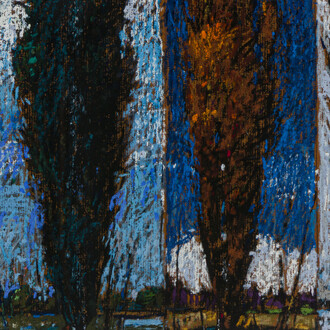Is it possible to create artwork that is both monumental and intimate? Hung Liu, trained as a muralist at Beijing's Central Academy of Art, captured moments of deeply personal pathos in her heroically scaled canvases. Right now, at SFMoMA, viewers can see Liu's tiny landscapes she secretly painted during the Cultural Revolution as an act of defiance, as well as her massive oils depicting women in various contexts of work.
Liu, was a groundbreaking artist who valued human empathy and hard work. She foregrounded universally shared conditions of women’s lives, addressing global issues through the lens of individual experience. She used her rich trove of painterly skill to document the revolutionary changes she saw in the world in the late twentieth and early twenty-first centuries, from China to the United States and beyond. In works such as Comrade in Arms (above), Liu demonstrated her ability to move between historical content and the individual, emotional stories of the women affected by these momentous occurrences.
Near the end of her life, Liu's interest in major historical events led her to create a series of American portraits inspired by Dorothea Lange's 1930s-era photographs of migrants forced to move to the Western United States as a result of the Dust Bowl. Lange's humanistic photographs of women and children felt familiar to Liu, who shared their experience of having to leave her home due to famine and hardship.
Dustbowl Portrait II, shown above, demonstrates Liu's ability to capture intense emotions through bold, graphic brushstrokes and thick layers of paint. In this work, we see the troubled, complex, and perhaps hopeful expression of a young child coping with the trauma of displacement. In this painting as with her others, Liu imbued her subjects with an undeniable sense of possibility, of hope for the future.
Though it deals with very different political and cultural subject matter, Laundry Lady echoes the Dust Bowl portraits in its emotional complexity and sense of optimism. The work alludes to Liu's experience as a female Chinese immigrant in the United States. When Liu came to the U.S. from China in the 1980s, she found a country that was much less progressive than she had expected. Women had fewer freedoms than she anticipated, and due to stereotyping, Chinese immigrants were implicitly restricted to a small number of careers, including working in laundromats.
Laundry Lady communicates the prejudices experienced by female Chinese Americans, showing a woman dressed in confining, somewhat old fashioned clothing in a monochromatic setting. Despite the obvious limitations Chinese women in the U.S. faced, this woman looks out at the world with an ambiguous, somewhat positive expression on her face, perhaps telegraphing some hope for her future and the future of her community.
Hung Liu created a series of shaped canvas paintings such as this one in the early 1990s. Likely inspired by her revolutionary art mentor Allan Kaprow to break through the traditional canvas shape, Liu's shaped canvases were radical in both form and content. The Metropolitan Museum of Art, the Kemper Art Museum, SFMoMA, and other institutions have collected works from this significant series. Laundry Lady, available exclusively through Turner Carroll Gallery, is a remarkable example of Hung Liu's original shaped canvases.
Perhaps the most momentous historical event that Liu experience firsthand was the cultural and political upheaval during her young life in China. She was forced to migrate many times herself, and these conditions imbued her with a lifelong interest in the personal stories of migrants.
Travelogue conveys this interest in a breathtakingly complex visual story. It is a quintessential work in that it embodies multiple layers of Hung Liu’s personal symbolism. The Buddhist goddess-like figure of Tara, who represents mercy and safe passage, holds the migrating family as they make their journey. The red bovine figures reinforce the perseverance that will be necessary for their success. The painting embodies signature aspects of her style, such as her “weeping realism” drips and circles, as well as issues of migration, humanism, and references to the greatness of China’s past.
The upcoming exhibition will delve into the most personal and political examples of Hung Liu's artwork. Hung Liu's creations will live on, both through the intimacy of the memories she crafted and in her monumental, revolutionary spirit.
















